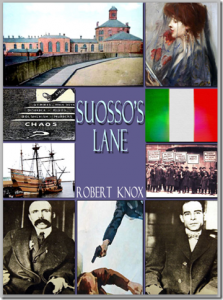 I'll be speaking on my novel "Suosso's Lane" and reading a few excerpts at the Paul Pratt Memorial Library in Cohasset, MA,
next Saturday, July 23. With terrorist attacks, attempted coups, and
right-wing targeting of immigrant groups, 2016 is growing remarkably
similar to the year 1920 when Nicola Sacco and Plymouth resident
Bartolomeo Vanzetti were arrested in a climate of violence and political
repression.
I'll be speaking on my novel "Suosso's Lane" and reading a few excerpts at the Paul Pratt Memorial Library in Cohasset, MA,
next Saturday, July 23. With terrorist attacks, attempted coups, and
right-wing targeting of immigrant groups, 2016 is growing remarkably
similar to the year 1920 when Nicola Sacco and Plymouth resident
Bartolomeo Vanzetti were arrested in a climate of violence and political
repression.In 1920 America was reeling from the effects of World War I, inflation, unemployment, increased crime, bootlegging violence and a bombing campaign that shocked and terrorized the nation even though casualties were few. Anarchists, a left-wing revolutionary group persecuted by the government for its opposition to American participation in the war, were blamed for the bombs. And many of America's anarchists were European immigrants.The federal government responded by targeting immigrants in massive round-ups, detainments, and deportation orders -- most of these later declared illegal -- in a campaign of repression called the Red Scare.
In this climate of fear and unease, a daring daylight payroll robbery in the quiet Massachusetts town of Braintree, accompanied by the killing of two payroll officials, shocked the public and was front-page news. Witnesses thought the criminals looked like immigrants from southern Europe. Maybe Italians. A local police chief theorized that the criminals were anarchists, because an Italian anarchist was renting a house in his town of Bridgewater and the car used in the holdup has been abandoned two miles away in the woods in Bridgewater. That was all he had to go on, but Sacco and Vanzetti, both Italian immigrants, and both anarchists, were charged with the crime when they were caught one night leaving the town of Bridgewater.
In a time of troubles when ordinary citizens worry about their safety, societies have a tendency to turn on members of "outsider" groups and suspect they're the cause of criminal acts. In the 2016 presidential election campaign, we've already seen a leading candidate make sweeping attacks on national and religious minorities. Should all Mexicans or Muslims be presumed to be the enemies of America's public safety? Can you imagine a time when people of Italian descent were looked at that way?
The events recounted in "Susosso's Lane," while they took place a long time ago, raise questions that are still with us. Do we learn from the past? Can we? Just maybe it helps to remember what happened long ago in 1920's America.
Here's the press release from the Cohasset library:
"Robert Knox, author of Suosso’s Lane, will give a book talk on Saturday, July 23, 2016 at the Paul Pratt Memorial Library, 35 Ripley Road, Cohasset 2:00-3:00 pm. The book is based on the scandalously unjust trial and execution of Sacco and Vanzetti for a murder most people believe they did not commit, the international cause-celebre of the 1920’s, Knox’s novel follows the search for evidence of Vanzetti’s innocence lost for decades to a government sanctioned frame-up.
"Free. All are welcome. Call the library for more information at 781-383-1348."

No comments:
Post a Comment